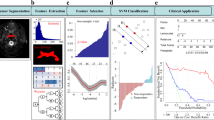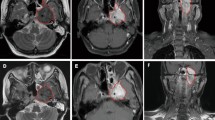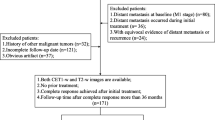Abstract
Recurrences are frequent in nasopharyngeal carcinoma (NPC) despite high remission rates with treatment, leading to considerable morbidity. This study aimed to develop a prediction model for NPC survival by harnessing both pre- and post-treatment magnetic resonance imaging (MRI) radiomics in conjunction with clinical data, focusing on 3-year progression-free survival (PFS) as the primary outcome. Our comprehensive approach involved retrospective clinical and MRI data collection of 276 eligible NPC patients from three independent hospitals (180 in the training cohort, 46 in the validation cohort, and 50 in the external cohort) who underwent MRI scans twice, once within 2 months prior to treatment and once within 10 months after treatment. From the contrast-enhanced T1-weighted images before and after treatment, 3404 radiomics features were extracted. These features were not only derived from the primary lesion but also from the adjacent lymph nodes surrounding the tumor. We conducted appropriate feature selection pipelines, followed by Cox proportional hazards models for survival analysis. Model evaluation was performed using receiver operating characteristic (ROC) analysis, the Kaplan–Meier method, and nomogram construction. Our study unveiled several crucial predictors of NPC survival, notably highlighting the synergistic combination of pre- and post-treatment data in both clinical and radiomics assessments. Our prediction model demonstrated robust performance, with an accuracy of AUCs of 0.66 (95% CI: 0.536–0.779) in the training cohort, 0.717 (95% CI: 0.536–0.883) in the testing cohort, and 0.827 (95% CI: 0.684–0.948) in validation cohort in prognosticating patient outcomes. Our study presented a novel and effective prediction model for NPC survival, leveraging both pre- and post-treatment clinical data in conjunction with MRI features. Its constructed nomogram provides potentially significant implications for NPC research, offering clinicians a valuable tool for individualized treatment planning and patient counseling.





Similar content being viewed by others
Data Availability
All data in this study can be obtained by contacting the corresponding authors upon reasonable request
References
X. Zhou, W. Zhao, Y. Chen, and Z. Zhang, “Chapter Six - Patient-derived tumor models for human nasopharyngeal carcinoma,” in Chick Chorioallantoic Membrane Model and Precision Cancer Therapy, vol. 46, F. B. T.-T. E. Tamanoi, Ed., Academic Press, 2019, pp. 81–96. https://doi.org/10.1016/bs.enz.2019.08.007.
L.-X. Peng and C.-N. Qian, “Chapter 17 - Nasopharyngeal Cancer,” S. G. B. T.-E. C. T. Gray, Ed., Boston: Academic Press, 2015, pp. 373–389. https://doi.org/10.1016/B978-0-12-800206-3.00017-3.
P. J. Slootweg and A. K. El-Naggar, “World Health Organization 4th edition of head and neck tumor classification: insight into the consequential modifications.” Virchows Archiv: an international journal of pathology, vol. 472, no. 3. Germany, pp. 311–313, Mar. 2018. https://doi.org/10.1007/s00428-018-2320-6.
Y. Wang, Y. Zhang, and S. Ma, “Racial differences in nasopharyngeal carcinoma in the United States.,” Cancer Epidemiol, vol. 37, no. 6, pp. 793–802, Dec. 2013. https://doi.org/10.1016/j.canep.2013.08.008.
H. Peng et al., “Prognostic value of deep learning PET/CT-based radiomics: Potential role for future individual induction chemotherapy in advanced nasopharyngeal carcinoma,” Clinical Cancer Research, vol. 25, no. 14, pp. 4271–4279, 2019. https://doi.org/10.1158/1078-0432.CCR-18-3065.
J. Yi et al., “Nasopharyngeal carcinoma treated by radical radiotherapy alone: Ten-year experience of a single institution.,” Int J Radiat Oncol Biol Phys, vol. 65, no. 1, pp. 161–168, May 2006. https://doi.org/10.1016/j.ijrobp.2005.12.003.
M. Kang et al., “Validation of the 8th edition of the UICC/AJCC staging system for nasopharyngeal carcinoma treated with intensity-modulated radiotherapy.,” Oncotarget, vol. 8, no. 41, pp. 70586–70594, Sep. 2017. https://doi.org/10.18632/oncotarget.19829.
S. Li, Y. Deng, Z. Zhu, H. Hua, and Z. Tao, A Comprehensive Review on Radiomics and Deep Learning for Nasopharyngeal Carcinoma Imaging. 2021.
P. Bossi et al., “Nasopharyngeal carcinoma: ESMO-EURACAN Clinical Practice Guidelines for diagnosis, treatment and follow-up,” Annals of Oncology, vol. 32, no. 4, pp. 452–465, 2021. https://doi.org/10.1016/j.annonc.2020.12.007.
Y.-P. Chen, A. T. C. Chan, Q.-T. Le, P. Blanchard, Y. Sun, and J. Ma, “Nasopharyngeal carcinoma,” The Lancet, vol. 394, no. 10192, pp. 64–80, Jul. 2019. https://doi.org/10.1016/S0140-6736(19)30956-0.
S. Wang, S. Chen, Q. Zhong, and Y. Liu, “Immunotherapy for the treatment of advanced nasopharyngeal carcinoma: a promising new era,” J Cancer Res Clin Oncol, 2022. https://doi.org/10.1007/s00432-022-04214-8.
V. Kaartemo and A. Helkkula, “A Systematic Review of Artificial Intelligence and Robots in Value Co-creation: Current Status and Future Research Avenues,” Journal of Creating Value, vol. 4, Oct. 2018. https://doi.org/10.1177/2394964318805625.
W. M. Yu and S. S. M. Hussain, “Incidence of nasopharyngeal carcinoma in Chinese immigrants, compared with Chinese in China and South East Asia: review.,” J Laryngol Otol, vol. 123, no. 10, pp. 1067–1074, Oct. 2009. https://doi.org/10.1017/S0022215109005623.
S. Li et al., “Deep learning for locally advanced nasopharyngeal carcinoma prognostication based on pre- and post-treatment MRI,” Comput Methods Programs Biomed, vol. 219, p. 106785, 2022. https://doi.org/10.1016/j.cmpb.2022.106785.
S. Jiang, L. Han, L. Liang, and L. Long, “Development and validation of an MRI-based radiomic model for predicting overall survival in nasopharyngeal carcinoma patients with local residual tumors after intensity-modulated radiotherapy,” BMC Med Imaging, vol. 22, no. 1, Dec. 2022. https://doi.org/10.1186/s12880-022-00902-6.
Y. Xi et al., “Early prediction of long-term survival of patients with nasopharyngeal carcinoma by multi-parameter MRI radiomics,” Eur J Radiol Open, vol. 12, Jun. 2024. https://doi.org/10.1016/j.ejro.2023.100543.
D. Bao et al., “Prognostic and predictive value of radiomics features at MRI in nasopharyngeal carcinoma,” Discover Oncology, vol. 12, no. 1, Dec. 2021. https://doi.org/10.1007/s12672-021-00460-3.
M. X. Sun, M. J. Zhao, L. H. Zhao, H. R. Jiang, Y. X. Duan, and G. Li, “A nomogram model based on pre-treatment and post-treatment MR imaging radiomics signatures: application to predict progression-free survival for nasopharyngeal carcinoma,” Radiation Oncology, vol. 18, no. 1, Dec. 2023. https://doi.org/10.1186/s13014-023-02257-w.
X. Yang, J. Wu, and X. Chen, “Application of Artificial Intelligence to the Diagnosis and Therapy of Nasopharyngeal Carcinoma,” Journal of Clinical Medicine, vol. 12, no. 9. Multidisciplinary Digital Publishing Institute (MDPI), May 01, 2023. https://doi.org/10.3390/jcm12093077.
Z. Lin, X. Zhang, Y. Luo, Y. Chen, and Y. Yuan, “The value of hemoglobin-to-red blood cell distribution width ratio (Hb/RDW), neutrophil-to-lymphocyte ratio (NLR), and platelet-to-lymphocyte ratio (PLR) for the diagnosis of nasopharyngeal cancer,” Medicine (United States), vol. 100, no. 28, p. E26537, Jul. 2021. https://doi.org/10.1097/MD.0000000000026537.
E. Kifle, M. Hussein, J. Alemu, and W. Tigeneh, “Prevalence of Anemia and Associated Factors among Newly Diagnosed Patients with Solid Malignancy at Tikur Anbessa Specialized Hospital, Radiotherapy Center, Addis Ababa, Ethiopia,” Adv Hematol, vol. 2019, p. 8279789, 2019. https://doi.org/10.1155/2019/8279789.
J. Zhu, R. Fang, Z. Pan, and X. Qian, “Circulating lymphocyte subsets are prognostic factors in patients with nasopharyngeal carcinoma,” BMC Cancer, vol. 22, no. 1, Dec. 2022. https://doi.org/10.1186/s12885-022-09438-y.
Y. Dai et al., “The effect of hispidulin, a flavonoid from salvia plebeia, on human nasopharyngeal carcinoma cne-2z cell proliferation, migration, invasion, and apoptosis,” Molecules, vol. 26, no. 6, Mar. 2021. https://doi.org/10.3390/molecules26061604.
M. Zhang, S. Wei, L. Su, W. Lv, and J. Hong, “Prognostic significance of pretreated serum lactate dehydrogenase level in nasopharyngeal carcinoma among Chinese population: A meta-analysis.,” Medicine, vol. 95, no. 35, p. e4494, Aug. 2016. https://doi.org/10.1097/MD.0000000000004494.
L. Huang et al., “Lactate dehydrogenase kinetics predict chemotherapy response in recurrent metastatic nasopharyngeal carcinoma.,” Ther Adv Med Oncol, vol. 12, p. 1758835920970050, 2020. https://doi.org/10.1177/1758835920970050.
J. Li et al., “Prognostic nomogram for patients with Nasopharyngeal Carcinoma incorporating hematological biomarkers and clinical characteristics.,” Int J Biol Sci, vol. 14, no. 5, pp. 549–556, 2018. https://doi.org/10.7150/ijbs.24374.
N. Lee et al., “Intensity-modulated radiation therapy with or without chemotherapy for nasopharyngeal carcinoma: Radiation therapy oncology group phase II trial 0225,” Journal of Clinical Oncology, vol. 27, no. 22, pp. 3684–3690, Aug. 2009. https://doi.org/10.1200/JCO.2008.19.9109.
M. B. Amin et al., “ The Eighth Edition AJCC Cancer Staging Manual: Continuing to build a bridge from a population‐based to a more ‘personalized’ approach to cancer staging ,” CA Cancer J Clin, vol. 67, no. 2, pp. 93–99, Mar. 2017. https://doi.org/10.3322/caac.21388.
C. C. Lee, J. C. Lee, W. Y. Huang, C. J. Juan, Y. M. Jen, and L. F. Lin, “Image-based diagnosis of residual or recurrent nasopharyngeal carcinoma may be a phantom tumor phenomenon,” Medicine (United States), vol. 100, no. 8, p. E24555, Feb. 2021. https://doi.org/10.1097/MD.0000000000024555.
A. A. K. Abdel Razek and A. King, “MRI and CT of nasopharyngeal carcinoma,” American Journal of Roentgenology, vol. 198, no. 1. pp. 11–18, Jan. 2012. https://doi.org/10.2214/AJR.11.6954.
M. W. van den Brekel et al., “Cervical lymph node metastasis: assessment of radiologic criteria.,” Radiology, vol. 177, no. 2, pp. 379–384, Nov. 1990. https://doi.org/10.1148/radiology.177.2.2217772.
T. Liu et al., “Radiomic signatures reveal multiscale intratumor heterogeneity associated with tissue tolerance and survival in re-irradiated nasopharyngeal carcinoma: a multicenter study,” BMC Med, vol. 21, no. 1, Dec. 2023. https://doi.org/10.1186/s12916-023-03164-3.
S. F. Su et al., “Treatment outcomes for different subgroups of nasopharyngeal carcinoma patients treated with intensity-modulated radiation therapy,” Chin J Cancer, vol. 30, no. 8, pp. 565–573, 2011. https://doi.org/10.5732/cjc.010.10547.
D. P. Shedd, C. F. von Essen, and H. Eisenberg, “Cancer of the nasopharynx in connecticut. 1935 through 1959,” Cancer, vol. 20, no. 4, pp. 508–511, Jan. 1967. https://doi.org/10.1002/1097-0142(1967)20:4<508::AID-CNCR2820200407>3.0.CO;2-I.
M.-C. Chen et al., “The incidence and risk of second primary cancers in patients with nasopharyngeal carcinoma: a population-based study in Taiwan over a 25-year period (1979–2003),” Annals of Oncology, vol. 19, no. 6, pp. 1180–1186, Jun. 2008. https://doi.org/10.1093/annonc/mdn003.
J. Friborg, J. Wohlfahrt, A. Koch, H. Storm, O. R. Olsen, and M. Melbye, “Cancer Susceptibility in Nasopharyngeal Carcinoma Families—A Population-Based Cohort Study,” Cancer Res, vol. 65, no. 18, pp. 8567–8572, Sep. 2005. https://doi.org/10.1158/0008-5472.CAN-04-4208.
T. S. De Silva, D. MacDonald, G. Paterson, K. C. Sikdar, and B. Cochrane, “Systematized nomenclature of medicine clinical terms (SNOMED CT) to represent computed tomography procedures,” Comput Methods Programs Biomed, vol. 101, no. 3, pp. 324–329, 2011. https://doi.org/10.1016/j.cmpb.2011.01.002.
S. Miao et al., “Development and validation of a risk prediction model for overall survival in patients with nasopharyngeal carcinoma: a prospective cohort study in China,” Cancer Cell Int, vol. 22, no. 1, Dec. 2022. https://doi.org/10.1186/s12935-022-02776-8.
B. Zhang, T. Zhang, L. Jin, Y. Zhang, and Q. Wei, “Treatment Strategy of Metastatic Nasopharyngeal Carcinoma With Bone Marrow Involvement—A Case Report,” Front Oncol, vol. 12, Jun. 2022. https://doi.org/10.3389/fonc.2022.877451.
J. Liu, C. Wei, H. Tang, Y. Liu, W. Liu, and C. Lin, “The prognostic value of the ratio of neutrophils to lymphocytes before and after intensity modulated radiotherapy for patients with nasopharyngeal carcinoma,” Medicine (United States), vol. 99, no. 2, Jan. 2020. https://doi.org/10.1097/MD.0000000000018545.
X. Zhong et al., “Cervical spine osteoradionecrosis or bone metastasis after radiotherapy for nasopharyngeal carcinoma? The MRI-based radiomics for characterization,” BMC Med Imaging, vol. 20, no. 1, p. 104, 2020. https://doi.org/10.1186/s12880-020-00502-2.
M. Bologna et al., “Baseline mri-radiomics can predict overall survival in non-endemic ebv-related nasopharyngeal carcinoma patients,” Cancers (Basel), vol. 12, no. 10, pp. 1–20, Oct. 2020. https://doi.org/10.3390/cancers12102958.
H. Shen et al., “Predicting Progression-Free Survival Using MRI-Based Radiomics for Patients With Nonmetastatic Nasopharyngeal Carcinoma,” Front Oncol, vol. 10, no. May, pp. 1–7, 2020. https://doi.org/10.3389/fonc.2020.00618.
S. D. McGarry et al., “Magnetic Resonance Imaging-Based Radiomic Profiles Predict Patient Prognosis in Newly Diagnosed Glioblastoma Before Therapy.,” Tomography, vol. 2, no. 3, pp. 223–228, Sep. 2016. https://doi.org/10.18383/j.tom.2016.00250.
R. Tibshirani, “Regression Shrinkage and Selection Via the Lasso,” Journal of the Royal Statistical Society: Series B (Methodological), vol. 58, no. 1, pp. 267–288, Jan. 1996. https://doi.org/10.1111/j.2517-6161.1996.tb02080.x.
J. Weng et al., “Clinical outcomes of residual or recurrent nasopharyngeal carcinoma treated with endoscopic nasopharyngectomy plus chemoradiotherapy or with chemoradiotherapy alone: A retrospective study,” PeerJ, vol. 2017, no. 10, 2017. https://doi.org/10.7717/peerj.3912.
H. L. Hua et al., “Deep learning for the prediction of residual tumor after radiotherapy and treatment decision-making in patients with nasopharyngeal carcinoma based on magnetic resonance imaging,” Quant Imaging Med Surg, vol. 13, no. 6, Jun. 2023. https://doi.org/10.21037/qims-22-1226.
J. L. Mi, M. Xu, C. Liu, and R. S. Wang, “Prognostic nomogram to predict the distant metastasis after intensity-modulated radiation therapy for patients with nasopharyngeal carcinoma,” Medicine (United States), vol. 100, no. 47, Nov. 2021. https://doi.org/10.1097/MD.0000000000027947.
L. Zhang et al., “Development and validation of a magnetic resonance imaging-based model for the prediction of distant metastasis before initial treatment of nasopharyngeal carcinoma: A retrospective cohort study,” EBioMedicine, vol. 40, pp. 327–335, Feb. 2019. https://doi.org/10.1016/j.ebiom.2019.01.013.
X. Zhang et al., “The effects of volume of interest delineation on MRI-based radiomics analysis: evaluation with two disease groups,” Cancer Imaging, vol. 19, no. 1, p. 89, 2019. https://doi.org/10.1186/s40644-019-0276-7.
J. Huang, R. He, J. Chen, S. Li, Y. Deng, and X. Wu, “Boosting Advanced Nasopharyngeal Carcinoma Stage Prediction Using a Two-Stage Classification Framework Based on Deep Learning,” International Journal of Computational Intelligence Systems, vol. 14, no. 1, 2021. https://doi.org/10.1007/s44196-021-00026-9.
S. Intarak et al., “Tumor Prognostic Prediction of Nasopharyngeal Carcinoma Using CT-Based Radiomics in Non-Chinese Patients,” Front Oncol, vol. 12, no. January, pp. 1–9, 2022. https://doi.org/10.3389/fonc.2022.775248.
M. Qiang et al., “A Prognostic Predictive System Based on Deep Learning for Locoregionally Advanced Nasopharyngeal Carcinoma,” JNCI: Journal of the National Cancer Institute, vol. 113, no. 5, pp. 606–615, May 2021. https://doi.org/10.1093/jnci/djaa149.
R.-X. Cen and Y.-G. Li, “Platelet-to-lymphocyte ratio as a potential prognostic factor in nasopharyngeal carcinoma: A meta-analysis.,” Medicine, vol. 98, no. 38, p. e17176, Sep. 2019. https://doi.org/10.1097/MD.0000000000017176.
S. J. Kim, J. Y. Choi, Y. C. Ahn, M. J. Ahn, and S. H. Moon, “The prognostic value of radiomic features from pre- and post-treatment 18F-FDG PET imaging in patients with nasopharyngeal carcinoma,” Sci Rep, vol. 13, no. 1, Dec. 2023. https://doi.org/10.1038/s41598-023-35582-x.
Y. Xi et al., “Prediction of Response to Induction Chemotherapy Plus Concurrent Chemoradiotherapy for Nasopharyngeal Carcinoma Based on MRI Radiomics and Delta Radiomics: A Two-Center Retrospective Study,” Front Oncol, vol. 12, Apr. 2022. https://doi.org/10.3389/fonc.2022.824509.
X. Bin et al., “Nomogram Based on Clinical and Radiomics Data for Predicting Radiation-induced Temporal Lobe Injury in Patients with Non-metastatic Stage T4 Nasopharyngeal Carcinoma,” Clin Oncol, vol. 34, no. 12, pp. e482–e492, Dec. 2022. https://doi.org/10.1016/j.clon.2022.07.007.
P. Bos et al., “Improved outcome prediction of oropharyngeal cancer by combining clinical and MRI features in machine learning models,” Eur J Radiol, vol. 139, no. March, p. 109701, 2021. https://doi.org/10.1016/j.ejrad.2021.109701.
Y.-Y. Huang, X. Cao, Z.-C. Cai, J.-Y. Zhou, X. Guo, and X. Lv, “Short-term efficacy and long-term survival of nasopharyngeal carcinoma patients with radiographically visible residual disease following observation or additional intervention: A real-world study in China,” Laryngoscope Investig Otolaryngol, vol. 7, no. 6, pp. 1881–1892, Dec. 2022. https://doi.org/10.1002/lio2.980.
V. P. Balachandran, M. Gonen, J. J. Smith, and R. P. DeMatteo, “Nomograms in oncology: more than meets the eye,” Lancet Oncol, vol. 16, no. 4, pp. e173–e180, Apr. 2015. https://doi.org/10.1016/S1470-2045(14)71116-7.
Q.-J. Li et al., “A Nomogram Based on Serum Biomarkers and Clinical Characteristics to Predict Survival in Patients With Non-Metastatic Nasopharyngeal Carcinoma,” Front Oncol, vol. 10, 2020, [Online]. Available: https://www.frontiersin.org/articles/10.3389/fonc.2020.594363
S. Faccioli, O. Cavicchi, U. Caliceti, A. R. Ceroni, and P. Chieco, “Cell proliferation as an independent predictor of survival for patients with advanced nasopharyngeal carcinoma.,” Mod Pathol, vol. 10 9, pp. 884–94, 1997, [Online]. Available: https://api.semanticscholar.org/CorpusID:24871135
M. A. Hernán, “The hazards of hazard ratios,” Epidemiology, vol. 21, no. 1. pp. 13–15, Jan. 2010. https://doi.org/10.1097/EDE.0b013e3181c1ea43.
Funding
The study is supported by TMU—Wan Fang Research grant no. 111TMU-WFH-13.
Author information
Authors and Affiliations
Corresponding author
Ethics declarations
Conflict of Interest
The authors declare no competing interests.
Additional information
Publisher's Note
Springer Nature remains neutral with regard to jurisdictional claims in published maps and institutional affiliations.
Supplementary Information
Below is the link to the electronic supplementary material.
Rights and permissions
Springer Nature or its licensor (e.g. a society or other partner) holds exclusive rights to this article under a publishing agreement with the author(s) or other rightsholder(s); author self-archiving of the accepted manuscript version of this article is solely governed by the terms of such publishing agreement and applicable law.
About this article
Cite this article
Dang, L.H., Hung, SH., Le, N.T.N. et al. Enhancing Nasopharyngeal Carcinoma Survival Prediction: Integrating Pre- and Post-Treatment MRI Radiomics with Clinical Data. J Digit Imaging. Inform. med. (2024). https://doi.org/10.1007/s10278-024-01109-7
Received:
Revised:
Accepted:
Published:
DOI: https://doi.org/10.1007/s10278-024-01109-7




